Edit Radar for Current Site
After adding a radar to an area of the current site, you can edit the parameters of the radar, including map settings, zone settings, camera calibration, and event settings.
Make sure you have configured GIS map. See Set GIS Map and Icons for details about configuring GIS map.
- Click Logical View on the Home page to enter the Area Management page.
-
In the area list panel, select the added current site from the drop-down site
list to show its areas.
Note:
The icon
 indicates that the site
is current site.
indicates that the site
is current site. - Select an area.
- Select the Radars tab to show the added radars.
- Click a radar's name in the Name column to enter the Edit Radar page.
- Edit the radar's name in Basic Information field.
-
Edit Map Settings.
Figure 1. Edit Radar Page
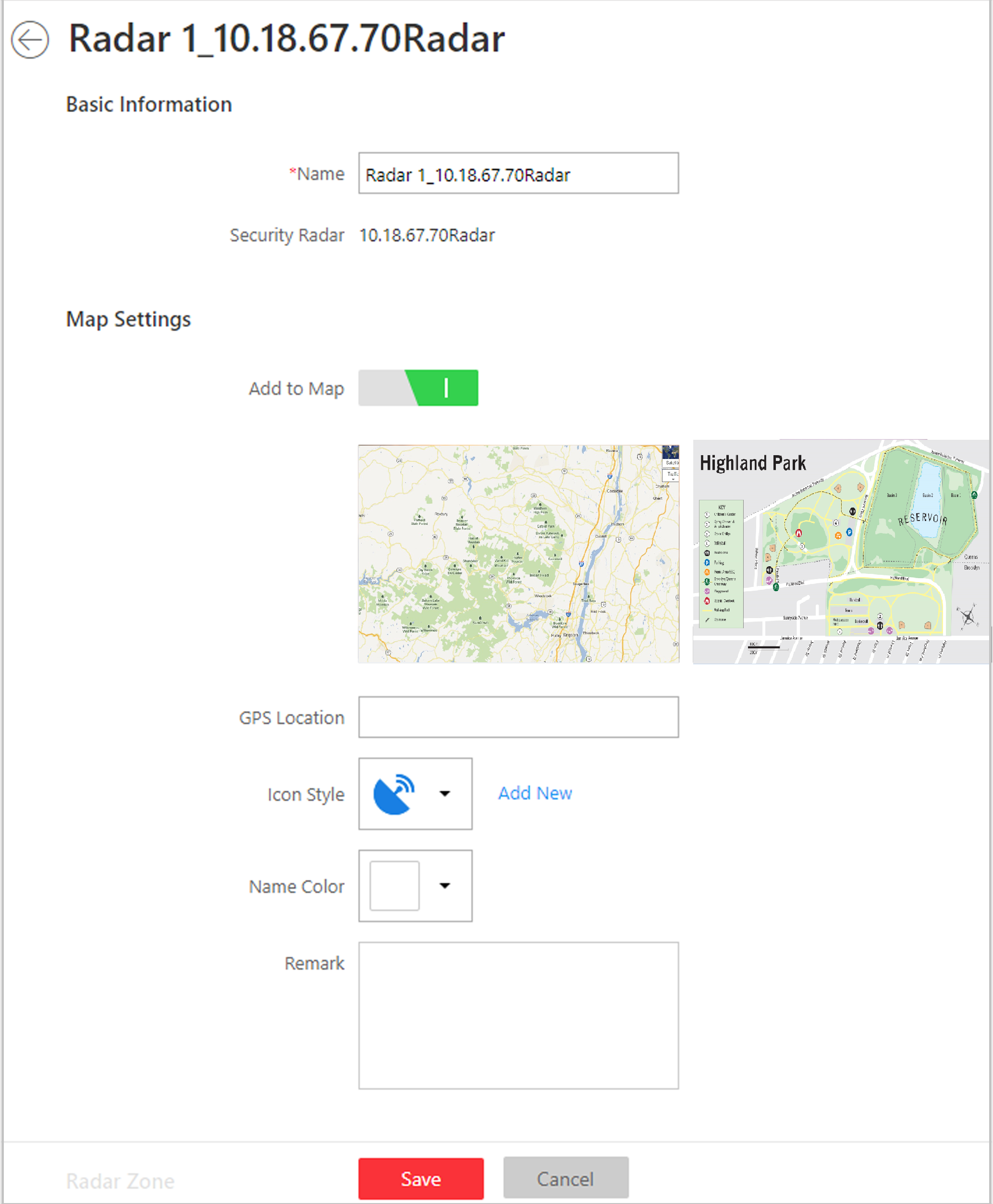
-
Enter the GPS Location for the radar.
Note:
Enter a place name and the searching results will pop up. Select a result in the list.
-
Select an icon and name color on the map for the radar.
Note:
You can click Add New to upload a new icon picture saved in your computer.
-
Enter the GPS Location for the radar.
-
Configure radar zone.
- Click the radar's icon on the map and then click Draw Zone to start drawing a zone.
-
Select a zone drawing method in the tool bar in the upper-left corner
of the map.
Figure 2. Tool Bar for Drawing Zone

 Draw Trigger
Line
Draw Trigger
Line-
A trigger line is a virtual line drawn in the radar's detection area. An event or alarm will be triggered if an object is detected to have crossed the line. Click to draw a trigger line in the detection area. Select a direction for the trigger line. The three directions indicate three directions to which a detected object crosses the line. You can drag the anchor (the red point on the trigger line) to reshape the trigger line, or drag the trigger line to move it to another place.
Note:No more than 4 trigger lines can be drawn.
Figure 3. Trigger Line in the Detection Area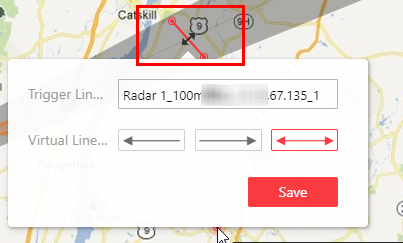
 Draw
Dual-Trigger Line
Draw
Dual-Trigger Line-
A dual-trigger line consists of 2 virtual lines drawn in the radar's detection area. Generally, it is used to mark an area in the radar's detection area. An event or alarm will be triggered if an object is detected to have entered the area shaped by the dual-trigger line. Click to draw a dual-trigger line in the detection area. Select a direction for the trigger line. The three directions indicate three directions to which a detected object crosses the line. You can drag the anchor (the red point on the trigger line) to reshape the dual-trigger line, or drag the dual-trigger line to move it to another place.
Note:Only 1 dual-trigger line can be drawn in the radar's detection area.
Figure 4. Dual-Trigger Line in the Detection Area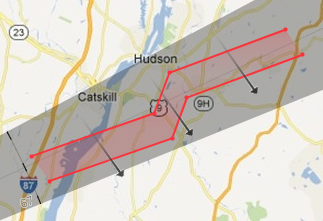
 Manually
Draw
Manually
Draw-
You can draw any shape for the zone using this method.
 Zone
Segmentation
Zone
Segmentation-
Split a zone into two smaller zones by a line.
Figure 5. Zone Segmentation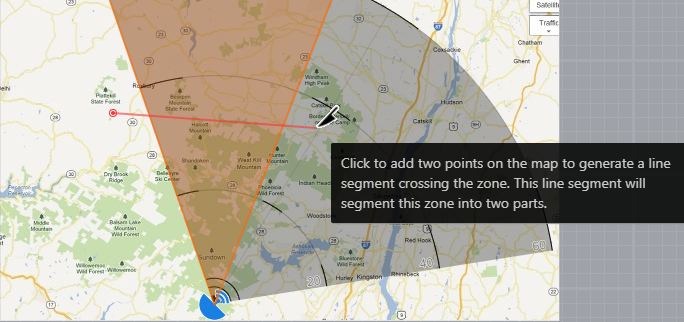
 Distance
Segmentation
Distance
Segmentation-
Split a zone into two smaller zone by an arc.
Figure 6. Distance Segmentation
 Field
Assistance
Field
Assistance-
Click to enable zone painting assistance function. For example, person A takes an on-site walk along the field to shape a closed figure as a zone. And then the moving path will automatically be painted as a zone on the map and a window for selecting zone type will pop up. And then Person B which operating the computer running the Web Client select a type for the zone.
-
Set related calibrated camera(s) for radar.
Note:
This operation requires two persons' teamwork: person A walks into the radar's detection area (the person's position will be displayed on the map as a red point
 ), while person B who
operates the computer running the Web Client adds calibration points by
PTZ control of the calibrated camera(s) according to person A's
position.Figure 7. Add Calibration Point Window
), while person B who
operates the computer running the Web Client adds calibration points by
PTZ control of the calibrated camera(s) according to person A's
position.Figure 7. Add Calibration Point Window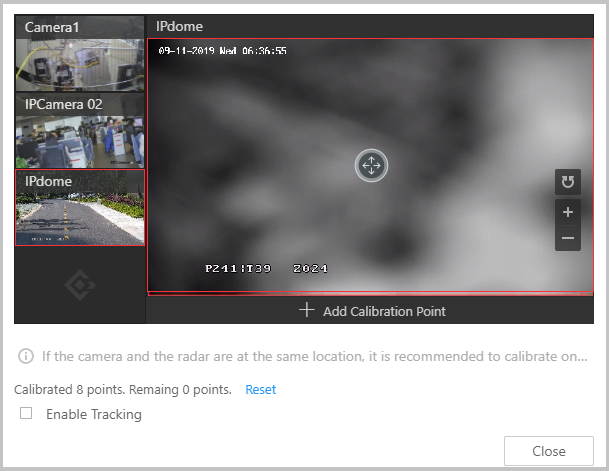
-
Click Add to select a camera in the area
list.
Note:
-
This function needs to be supported by the device.
-
Up to 4 calibrated cameras can be added.
The added cameras are displayed in a form.
-
-
Person A goes to the location which can be detected by one of the
calibrated cameras. Person B clicks
 in the Operation
column.
in the Operation
column.
Person A's location will appear on the map as a red point
 .
. -
Click
 to open the adding
calibration point window.
to open the adding
calibration point window.
The calibrated cameras' thumbnails will be displayed on the left.
- Optional: Undo-check the Enable Tracking if you have enabled visual tracking for the calibrated cameras.
- Click a calibrated camera's thumbnail to display its image in the window on the right.
- Click the image to turn the camera to the position of person A until person A appears in the image.
-
Click Add Calibration Point to add the current
image as a calibration point.
Note:
-
If the calibrated camera locates above or under the radar vertically, only 1 calibration point is enough; if not, at least 4 calibration points are required.
-
Up to 8 calibration points can be added for one calibrated cameras.
-
- Optional: Check Enable Tracking if you have enabled visual tracking for the calibrated cameras.
-
Close the Add Calibration Point window and click
 to save the
settings.
to save the
settings.
-
Click Add to select a camera in the area
list.
- Optional: Click Configuration to set event for the radar. See Configure Event and Alarm for details.
- Click Save to save the settings for the radar.
- Legal Information
- Symbol Conventions
- About Web Client
- Login
- Download Mobile Client
- Web Control
- Manage License
- Manage Resource
- Create Password for Inactive Device(s)
- Edit Online Device's Network Information
- Manage Encoding Device
- Add Detected Online Device
- Add Encoding Device by IP Address or Domain Name
- Add Encoding Devices by IP Segment
- Add Encoding Devices by Port Segment
- Add Encoding Device by Hik-Connect DDNS
- Add Encoding Device by Device ID
- Add Encoding Devices by Device ID Segment
- Add Encoding Devices in a Batch
- Limit Bandwidth for Video Downloading
- Set N+1 Hot Spare for NVR
- Network Transmission Device Management
- Upgrade Device Firmware
- Restore/Reset Device Password
- Manage Remote Site
- Manage Application Data Server
- Manage Recording Server
- Manage Streaming Server
- Manage DeepinMind Server
- Add Security Audit Server
- Manage Smart Wall
- Manage Area
- Add Area
- Add Element to Area
- Edit Element in Area
- Edit Camera for Current Site
- Configure Visual Tracking
- Configure Smart Linkage
- Edit Door for Current Site
- Edit Elevator for Current Site
- Edit Radar for Current Site
- Edit Alarm Input for Current Site
- Edit Alarm Output for Current Site
- Edit Under Vehicle Surveillance System for Current Site
- Edit Third-Party Integrated Resource for Current Site
- Edit Element for Remote Site
- Remove Element from Area
- Manage Resource Group
- Configure Recording
- Configure Event and Alarm
- Manage Map
- Manage Person List
- Manage Visitor
- Manage Access Control and Elevator Control
- Flow Chart
- Manage Access Control Device
- Manage Elevator Control Device
- Manage Access Level
- Access Control Test
- Advanced Functions
- Manage Video Intercom
- Flow Chart
- Manage Video Intercom Device
- Batch Link Persons with Indoor Station
- Relate Doorbell with Indoor Station
- Configure Device Parameters
- Manage Time and Attendance
- Flow Chart
- Add Attendance Group
- Add Timetable
- Add Shift Schedule
- Assign Shift Schedule to Attendance Group
- Configure Attendance Parameters
- Manage Attendance Record
- Search Attendance Record
- Correct Attendance Record for Single Person
- Correct Check-In/Out for Multiple Persons
- Apply for Leave for Single Person
- Apply for Leave for Multiple Persons
- Manually Calculate Attendance Results
- Export Attendance Records
- Get Attendance Records from Device
- View Attendance Handling Records
- Configure Attendance Report
- Manage Entrance and Exit
- Manage Facial Comparison
- Dock Station
- Manage Security Control
- Manage Security Control Device
- Add Detected Online Device
- Add Security Control Device by IP Address
- Add Security Control Device by Hik-Connect DDNS
- Add Security Control Devices by IP Segment
- Add Security Control Devices by Port Segment
- Add Security Control Device by Device ID
- Add Security Control Device by Device ID Segment
- Add Security Control Devices in a Batch
- Add Security Control Partitions from Device
- Configure Defense Schedule Template
- Manage Security Control Device
- Manage Role and User
- Maintenance
- Manage System Security
- System Configuration
- Set Site Name
- Set User Preference
- Set Warning Threshold for Server Usage
- Set Printer
- Set NTP
- Set Active Directory
- Enable Receiving Generic Event
- Allow for Remote Site Registration
- Register to Central System
- Device Access Protocol
- Set WAN Access
- Set Network Timeout
- Set Device Access Mode
- Set IP Address for Receiving Device Information
- Set Data Retention Period
- Set Holiday
- Set Email Template
- Send Report Regularly
- Enable Evidence Collection
- Set Transfer Protocol
- Set Camera ID
- Export Service Component Certificate
- Set Database Password
- Set Health Check Frequency
- Add Fuzzy Matching Rules for License Plate Search
- Configure System Hot Spare
- Set Third-Party Integration
- Data Interchange
- Reset Device Network Information
- Set SUP Upgrade Prompt
- Monitoring
- Intelligent Analysis Report
- Skin-surface Temperature
- Important Ports
Edit Radar for Current Site
After adding a radar to an area of the current site, you can edit the parameters of the radar, including map settings, zone settings, camera calibration, and event settings.
Make sure you have configured GIS map. See Set GIS Map and Icons for details about configuring GIS map.
- Click Logical View on the Home page to enter the Area Management page.
-
In the area list panel, select the added current site from the drop-down site
list to show its areas.
Note:
The icon
 indicates that the site
is current site.
indicates that the site
is current site. - Select an area.
- Select the Radars tab to show the added radars.
- Click a radar's name in the Name column to enter the Edit Radar page.
- Edit the radar's name in Basic Information field.
-
Edit Map Settings.
Figure 1. Edit Radar Page

-
Enter the GPS Location for the radar.
Note:
Enter a place name and the searching results will pop up. Select a result in the list.
-
Select an icon and name color on the map for the radar.
Note:
You can click Add New to upload a new icon picture saved in your computer.
-
Enter the GPS Location for the radar.
-
Configure radar zone.
- Click the radar's icon on the map and then click Draw Zone to start drawing a zone.
-
Select a zone drawing method in the tool bar in the upper-left corner
of the map.
Figure 2. Tool Bar for Drawing Zone

 Draw Trigger
Line
Draw Trigger
Line-
A trigger line is a virtual line drawn in the radar's detection area. An event or alarm will be triggered if an object is detected to have crossed the line. Click to draw a trigger line in the detection area. Select a direction for the trigger line. The three directions indicate three directions to which a detected object crosses the line. You can drag the anchor (the red point on the trigger line) to reshape the trigger line, or drag the trigger line to move it to another place.
Note:No more than 4 trigger lines can be drawn.
Figure 3. Trigger Line in the Detection Area
 Draw
Dual-Trigger Line
Draw
Dual-Trigger Line-
A dual-trigger line consists of 2 virtual lines drawn in the radar's detection area. Generally, it is used to mark an area in the radar's detection area. An event or alarm will be triggered if an object is detected to have entered the area shaped by the dual-trigger line. Click to draw a dual-trigger line in the detection area. Select a direction for the trigger line. The three directions indicate three directions to which a detected object crosses the line. You can drag the anchor (the red point on the trigger line) to reshape the dual-trigger line, or drag the dual-trigger line to move it to another place.
Note:Only 1 dual-trigger line can be drawn in the radar's detection area.
Figure 4. Dual-Trigger Line in the Detection Area
 Manually
Draw
Manually
Draw-
You can draw any shape for the zone using this method.
 Zone
Segmentation
Zone
Segmentation-
Split a zone into two smaller zones by a line.
Figure 5. Zone Segmentation
 Distance
Segmentation
Distance
Segmentation-
Split a zone into two smaller zone by an arc.
Figure 6. Distance Segmentation
 Field
Assistance
Field
Assistance-
Click to enable zone painting assistance function. For example, person A takes an on-site walk along the field to shape a closed figure as a zone. And then the moving path will automatically be painted as a zone on the map and a window for selecting zone type will pop up. And then Person B which operating the computer running the Web Client select a type for the zone.
-
Set related calibrated camera(s) for radar.
Note:
This operation requires two persons' teamwork: person A walks into the radar's detection area (the person's position will be displayed on the map as a red point
 ), while person B who
operates the computer running the Web Client adds calibration points by
PTZ control of the calibrated camera(s) according to person A's
position.Figure 7. Add Calibration Point Window
), while person B who
operates the computer running the Web Client adds calibration points by
PTZ control of the calibrated camera(s) according to person A's
position.Figure 7. Add Calibration Point Window
-
Click Add to select a camera in the area
list.
Note:
-
This function needs to be supported by the device.
-
Up to 4 calibrated cameras can be added.
The added cameras are displayed in a form.
-
-
Person A goes to the location which can be detected by one of the
calibrated cameras. Person B clicks
 in the Operation
column.
in the Operation
column.
Person A's location will appear on the map as a red point
 .
. -
Click
 to open the adding
calibration point window.
to open the adding
calibration point window.
The calibrated cameras' thumbnails will be displayed on the left.
- Optional: Undo-check the Enable Tracking if you have enabled visual tracking for the calibrated cameras.
- Click a calibrated camera's thumbnail to display its image in the window on the right.
- Click the image to turn the camera to the position of person A until person A appears in the image.
-
Click Add Calibration Point to add the current
image as a calibration point.
Note:
-
If the calibrated camera locates above or under the radar vertically, only 1 calibration point is enough; if not, at least 4 calibration points are required.
-
Up to 8 calibration points can be added for one calibrated cameras.
-
- Optional: Check Enable Tracking if you have enabled visual tracking for the calibrated cameras.
-
Close the Add Calibration Point window and click
 to save the
settings.
to save the
settings.
-
Click Add to select a camera in the area
list.
- Optional: Click Configuration to set event for the radar. See Configure Event and Alarm for details.
- Click Save to save the settings for the radar.